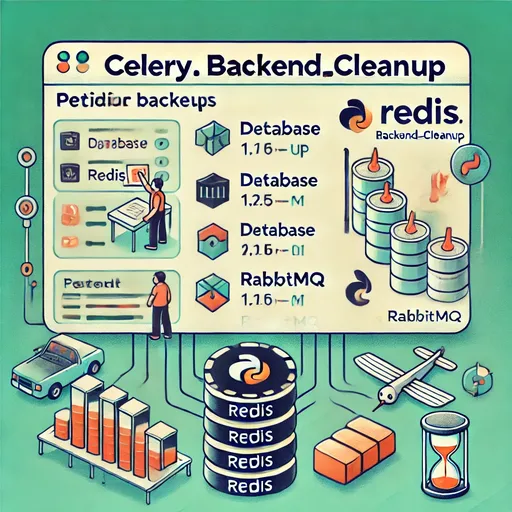Django-celery-beat is a powerful tool that periodically executes Celery tasks while automatically cleaning up unnecessary data piling up in the backend. Each storage option, such as Redis, database, and RabbitMQ, has different characteristics, and therefore, the methods for accumulating and managing data can vary. In this post, we will examine the features of various backends and specifically look at how Django-celery-beat manages memory usage when using Redis.
1. Characteristics of Various Backends and the Need for Tailored Management with Django-celery-beat
Celery supports various result backends, each requiring different memory management strategies based on its characteristics. This allows for the establishment of optimized cleanup cycles tailored to the backend, optimizing memory usage.
- Database: When using an SQL database as the backend, task results are permanently stored. This is advantageous when frequent result lookups are needed, but as data accumulates, it may impact query speed and performance.
- Redis: Redis is an in-memory database that boasts fast data retrieval speeds. It is suitable for tasks that require real-time processing but can degrade performance if task results continue to pile up, increasing memory usage.
- RabbitMQ: Primarily used as a message queue, it stores results by delivering messages to the queue upon task completion. It is suited for message-based workflows but has limitations in long-term storage of task results.
As each backend accumulates data differently, the need for periodic data cleanup (cloud-based cleanup) may arise at different times. Django-celery-beat automatically adds cleanup tasks tailored to the data usage patterns of the backend, allowing adjustments to be made through Django Admin as needed.
2. Redis Example: A Suitable Backend for Real-Time Data Processing and the Role of Django-celery-beat in Memory Optimization
Redis is widely used as a Celery result backend and is ideal for real-time data processing that requires fast processing speeds. However, as task results accumulate in memory, they can directly affect server performance, making periodic cleanup essential. Django-celery-beat automatically adds the celery.backend_cleanup task in applications utilizing Redis, ensuring that old data does not remain in Redis.
- The Importance of Memory Management: While Redis allows for fast data retrieval, its in-memory nature means that as data accumulates, memory usage can significantly increase, adversely affecting performance. Django-celery-beat sets a cleanup cycle tailored to this characteristic, optimizing memory usage in Redis.
- Setting Appropriate Cleanup Cycles: By adjusting the cleanup task cycle in Django Admin, it is possible to optimize the frequency of cleanups based on Redis usage and workflow patterns. For instance, if there are many tasks, the cleanup cycle can be set shorter to prevent excessive memory usage.
Collaboration Process Between Redis and Django-celery-beat:
- Automatic Cleanup Task Registration: Once the Redis backend is set up, Django-celery-beat automatically registers
celery.backend_cleanupto periodically clean up unnecessary data, preventing it from lingering. - Management Cycle Adjustment via Django Admin: Based on Redis usage, the cleanup cycle can be adjusted for efficient management, making it easy to apply optimal memory management settings based on task characteristics.
Conclusion
In conclusion, we have discussed the in-depth memory management processes with various Celery backends and Django-celery-beat. In the next part, we will delve deeper into setting expiration for Celery task results and methods for periodic cleanup management.

There are no comments.